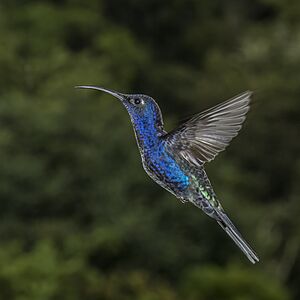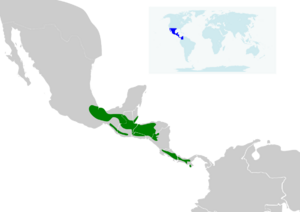Violet sabrewing facts for kids
Quick facts for kids Violet sabrewing |
|
|---|---|
 |
|
| Male, Panama | |
| Conservation status | |
| Scientific classification | |
| Genus: |
Campylopterus
|
| Species: |
hemileucurus
|
 |
|
| Range of C. hemileucurus | |
The violet sabrewing (Campylopterus hemileucurus) is a beautiful type of hummingbird. These amazing birds are known for their bright colors and fast wings. You can find them living in areas from Mexico all the way down to Panama.
Contents
About the Violet Sabrewing
The violet sabrewing is the biggest hummingbird found in Mexico and Central America. It grows to be about 13 to 15 centimeters (5 to 6 inches) long. It weighs around 9 to 12 grams (0.3 to 0.4 ounces).
Both male and female sabrewings have a black beak. However, some groups of these birds have slightly longer beaks.
What They Look Like
Male violet sabrewings have a dark head with a shiny blue-green look. Their neck, upper back, face, and belly are a bright, metallic violet-blue. This color is a bit bluer on their tummy. Their lower back and tail feathers are metallic green. The middle tail feathers are blue-green or blue-black. The other tail feathers are blackish with wide white tips.
Female sabrewings have a dark head and shiny green or bronze-green upper parts. Their rump (lower back) is more blue-green. Their throat is a pretty violet-blue. Most of their belly is gray, with a whiter tummy. They have metallic green spots along their sides. Their middle tail feathers are blue-green, and the rest are blacker with wide white tips.
There are two main types, or subspecies, of violet sabrewings. One type has more green on its upper body and almost completely violet underparts. The females of this type have a coppery shine on their upper parts and a violet throat.
Where They Live
The violet sabrewing lives in different parts of Central America. One type is found from the Mexican states of Guerrero and Veracruz. It also lives in Guatemala, southern Belize, Honduras, El Salvador, and northern Nicaragua. The other type lives mostly in Costa Rica and western Panama.
These hummingbirds like to live in humid evergreen montane forests. These are forests on mountains that stay green all year. They also live in older secondary forests, which are forests that have grown back after being cut down. You might even spot them in banana farms and gardens!
In Mexico, they usually live at heights between 500 and 2000 meters (1,600 to 6,500 feet). Sometimes, they can be found as high as 2500 meters (8,200 feet). In Costa Rica, they prefer heights between 1500 and 2400 meters (4,900 to 7,900 feet).
How They Live
Violet sabrewings usually stay in one area. However, some birds might move to lower places after the time when they raise their young.
What They Eat
Violet sabrewings mostly eat nectar from flowers. They are very smart about it! They often fly a specific path, visiting a circuit of flowering plants. This is called "trap-lining." Male sabrewings sometimes protect patches of flowers. They are stronger than other hummingbirds and will chase them away.
These birds mostly look for food in the lower parts of the forest. They love nectar from plants like Heliconia, banana plants (Musa), Cephalism, and Palic urea. They also visit other flowers. If you have a sugar water feeder for hummingbirds, they will visit it and might even chase other birds away! Besides nectar, violet sabrewings also eat small bugs and spiders they find on leaves or in spiderwebs.
Reproduction and Life Cycle
Violet sabrewings lay their eggs during the rainy season in their area. In Mexico, this is from June to September. In Costa Rica, it's from May to November. In Costa Rica, they might even raise two groups of babies in one season.
Male sabrewings try to attract females by singing. They often sing in special gathering spots, usually in the lower forest or at the edge of the forest.
The nest is shaped like a cup. It's made of moss and held together with spiderwebs. The inside is lined with soft fibers. In Costa Rica, nests are often built above a ravine or stream. They are usually on a horizontal branch, about 1 to 6 meters (3 to 20 feet) above the ground. The female bird sits on her two eggs for 19 to 22 days. The baby birds leave the nest about 22 to 24 days after they hatch.
Their Sounds
The song of the violet sabrewing is described as "cheep tsew cheep tik-tik tsew cheep." It's high-pitched, sharp, and sounds like it's coming from far away. People also describe it as "loud, sharp chipping and warbles." Sometimes it has shrill, slightly explosive notes. Their calls are "high, sharp chippering," "long, hard chipping," and "single sharp chips given when flying."
Conservation Status
The IUCN (International Union for Conservation of Nature) says the violet sabrewing is a species of "Least Concern." This means they are not currently in danger of disappearing. They live in a very large area. There are at least 50,000 adult birds, though their numbers might be slowly going down. No major threats have been found for them. These birds can even handle some changes to their habitat, as long as there's still some forest or tall new growth around.


